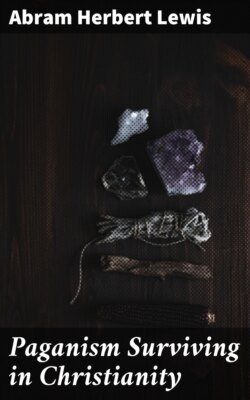Читать книгу Paganism Surviving in Christianity - Abram Herbert Lewis - Страница 5
На сайте Литреса книга снята с продажи.
Оглавление“In popular customs, and even in religious institutions, these things are as plainly perceived to-day as when Adonis and Astarte were the Gods of the former world. The sanctities, the powers, the symbols, and even the utensils of the ancient faith have been assumed, if not usurped or legitimately inherited, by its successors. The two holies of the Gnostics and Neo-Platonists, Sophia and Eirene—Wisdom and Peace—were adopted as saints in the calendar of Constantinople. Dionysius, the god of the mysteries, reappears as St. Denys in France, St. Liberius, St. Eleutherius, and St. Bacchus; there is also a St. Mithra; and even Satan, prince of shadows, is revered as St. Satur and St. Swithin. Their relics are in keeping. The holy virgin Astræa or Astarte, whose return was announced by Virgil in the days of Augustus, as introducing a new golden age, now under her old designation of Blessed Virgin and Queen of Heaven, receives homage as ‘the one whose sole divinity the whole orb of the earth venerates.’ The Mother and Child, the latter adorned with the nimbus or aureole of the ancient sun-gods, are now the objects of veneration as much as were Ceres and Bacchus, or Isis and Horus, in the mysteries. Nuns abounded alike in Christian and Buddhist countries, as they did formerly in Isis-worshipping Egypt; and if their maidenhood is not sacrificed at the shrine of Baal-Peor, or any of his cognate divinities, yet it is done in a figure; they are all ‘brides of the Saviour.’ Galli sing in the churches, and consecrated women are as numerous as of old. The priestly vestments are like those formerly used in the worship of Saturn and Cybele; the Phrygian cap, the pallium, the stole, and the alb. The whole Pantheon has been exhausted, from the Indus, Euphrates, and the Nile, to supply symbolic adornment for the apostles’ successors. Hercules holds the distaff of Omphale. The Lily has superseded the Lotus, and celibacy is exalted above the first recorded mandate of God to mankind. …
“It is true, doubtless, that there is not a fast or festival, procession or sacrament, social custom or religious symbol, that did not come ‘bodily’ from the previous paganism. But the pope did not import them on his own account; they had already been transferred into the ecclesiastical structure, and he only accepted and perhaps took advantage of the fact. Many of those who protest because of these corruptions are prone to imitate them more or less, displaying an engrafting from the same stock.”[23]
A late German writer of note and authority, Lechler, thus states the relative influence of paganism and Judaism on early Christianity:
“Putting together all that has been said, we get the impression that, in respect to the Gentile Christians in the second half of the Apostolic age, heathenism was the vastly predominant power that partly from without threatened the Church, and partly from within prepared the most hazardous disputes. It was an anti-Christian gnosis proceeding from heathen ideas; frequently also a moral error stained with heathen licentiousness, that became dangerous to souls. On the other hand, according to all the documents of that later apostolic time that we possess, Judaism, broken as a political power, was no longer a dangerous opponent of the Church of Christ as a spiritual power; the time in which Judaizing errorists possessed a powerful influence over spirits was visibly passed.”[24]
With such a preview, made up from writers of such authority and ability, the fact of the existence of an immense amount of pagan residuum in Christianity is placed beyond question. The reader may be surprised; may shrink from such facts. But shrinking from facts, or denying them, does not remove or destroy them. Facts are immortal. He who will take the trouble to follow through the successive chapters will see by what means, and in what ways, Christianity was corrupted, and whence came the pagan residuum that yet remains. Suggestions in outline will also be found, as to how the remaining residuum can be removed.
